Ayrton Light 1
Ayrton Light
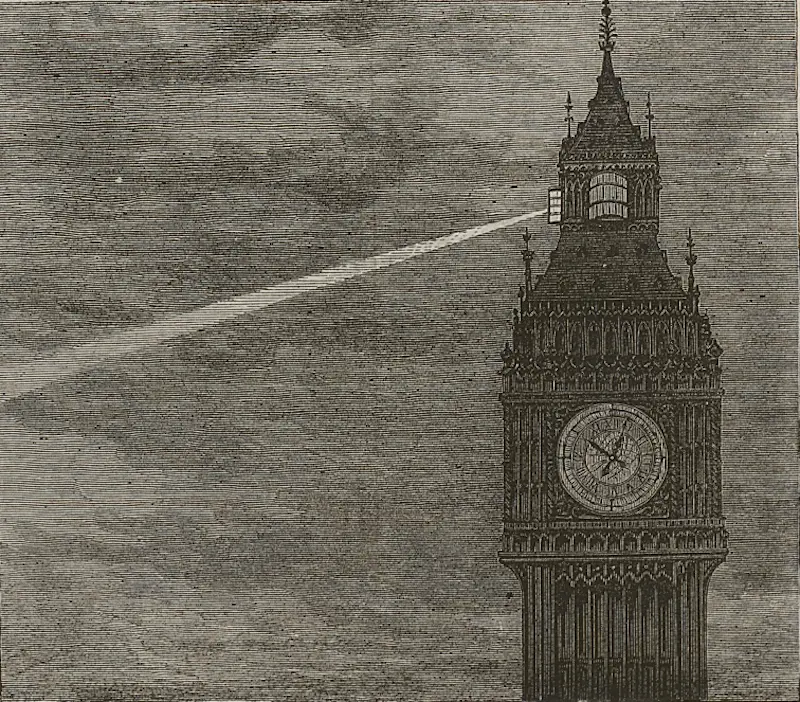
The Ayrton Light is 2.7m wide and 3.7m tall. It originally housed 68 gas burners, and was updated to electric lighting in 1906. It is now lit by energy-efficient LED lighting.
Ayrton Light 2
Jabez James
This plaque bears the name of Jabez James, whose foundry fashioned the cast and wrought iron in 1850s for the roof and the enormous frame which holds the five bells. He was also instrumental in the process of raising and hanging the bells.
Time capsule
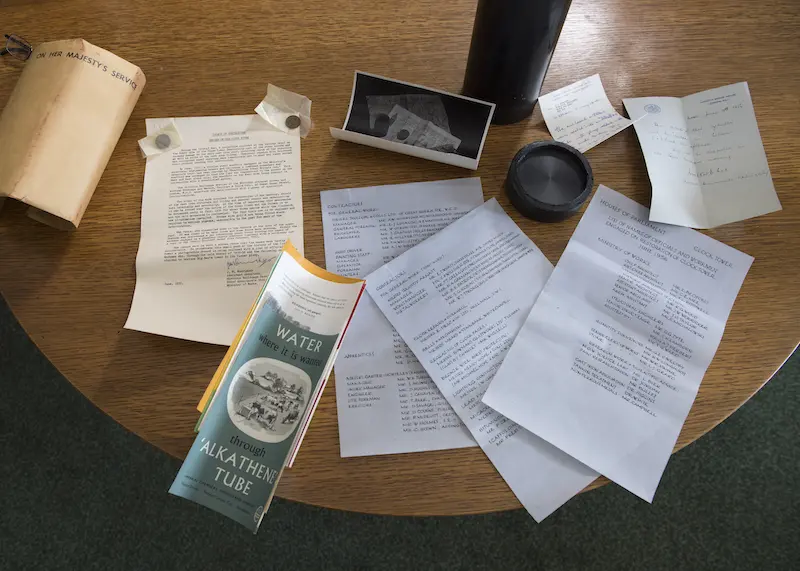

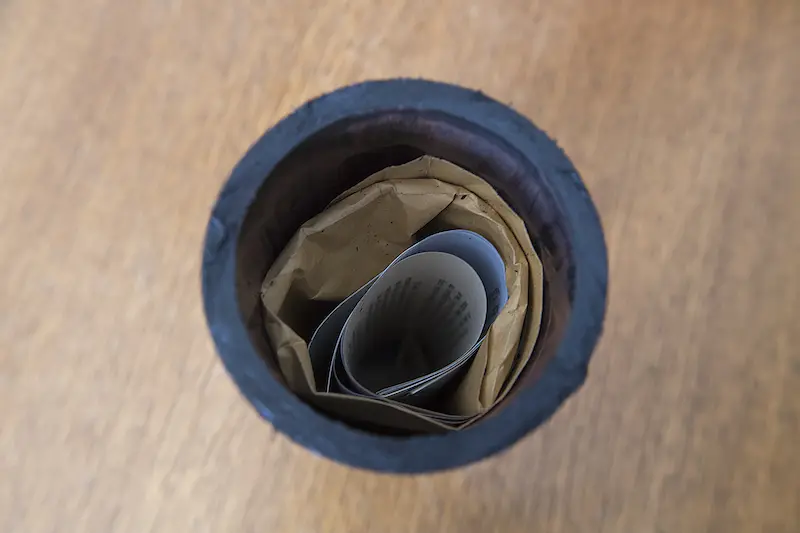
In 2019, a time capsule was discovered which had been hidden in the roof above the Ayrton Light in 1956. It contained the names of those who had worked on the tower and details of a previous time capsule they’d found, hidden in 1906. A new time capsule was placed here by the most recent project team.
Belfry 1
Big Ben
This is Big Ben. The great bronze bell is 2.2m tall and 2.7m in diameter. Striking at 120 decibels from 62m above the ground, the iconic ‘bongs’ can be heard from miles around. The 200kg hammer is controlled by the Strike Train in the Mechanism Room below.
Hour bongs
Cracked bell
Cast by Whitechapel Bell Foundry, Big Ben was the second attempt to cast a great bell, and it was transported to Westminster by 16 horses. Shortly after installation a small crack appeared, and after months of silence this square was cut out to prevent further cracking, the bell was turned, and the hammer weight reduced.
Credit: The Arrival of the New Bell Credit:
Alamy
Moving great bell for clock tower
of Westminster: Credit (Dea/Biblioteca
Ambrosiana/De Agostini) via Getty Images
Big
Ben Bell for the great clock of Westminster
Palace Credit: Alamy George Frederick
Sargent Big Ben, 1856 Credit: London Picture
Archive
Belfry 2
Westminster Chimes
The four chime bells play a melody which was inspired by the bells at Great St Mary’s Church in Cambridge, where Denison studied. They are controlled by the Chiming Train in the Mechanism Room below, and play every 15 minutes.
Stonework Conservation

Some of the stonework on the tower was replaced during the refurbishment project which ended in 2022, as time and pollution had damaged the original Yorkshire limestone. New pieces were hand-carved, and will change colour to match the existing stone over time.
Belfry 3
Broadcast
Microphones pick up the bells’ tolls for broadcast; 2023 marked the 100th anniversary of BBC Radio’s first broadcast of Big Ben on New Year’s Eve 1923. The bells can still be heard on BBC Radio 4 at 6pm and midnight.
Clock dials (external) 1
Restoring the dials
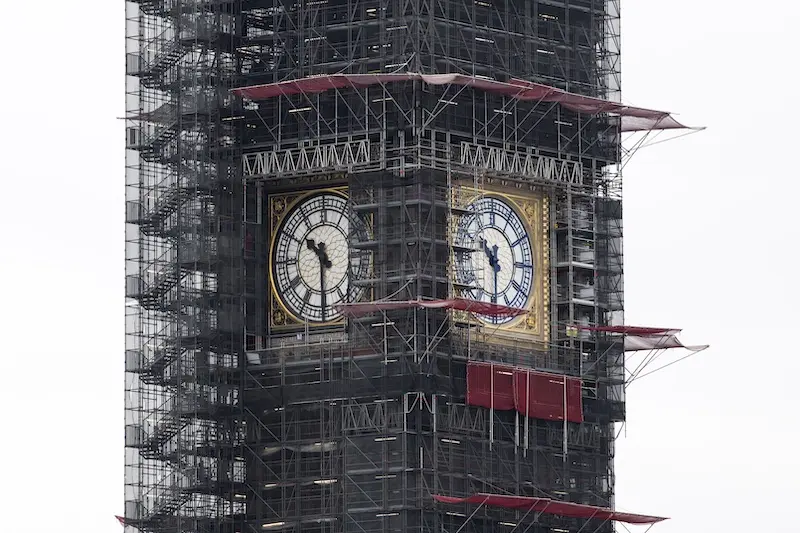
The paintwork on the clock face was changed to black in the 1930s to mask the effects of pollution, but Charles Barry’s original designs and historic paint analysis show it was originally blue. The paintwork, restored in Prussian blue, was unveiled in 2022.
Decoration
Shields decorate the outside of the Tower. Above the Belfry and Ayrton light there are emblems of roses, thistles, shamrocks and leeks to represent the four nations of the UK. There is a row of shields with St George’s red cross above each clock face.
Decoration
Victoria Tower
The Victoria Tower, which bookends the other side of the Palace of Westminster, is actually slightly taller than the Elizabeth Tower, standing at 98.5m. The Elizabeth Tower is 96.3m tall. At the base of Victoria Tower is Sovereign’s entrance, where the monarch enters the palace for the State Opening of Parliament.
Clock Dials (internal) Main
Glass
This milky white opal glass in the dials was replaced during a refurbishment project that finished in 2022. Mouth-blown glass was made in Germany especially for the dials, then cut and fitted by hand in London. The frame was restored in situ. There had been some bomb-damage to the South Dial in 1941, but none to the clock or bells.
Lighting the dials
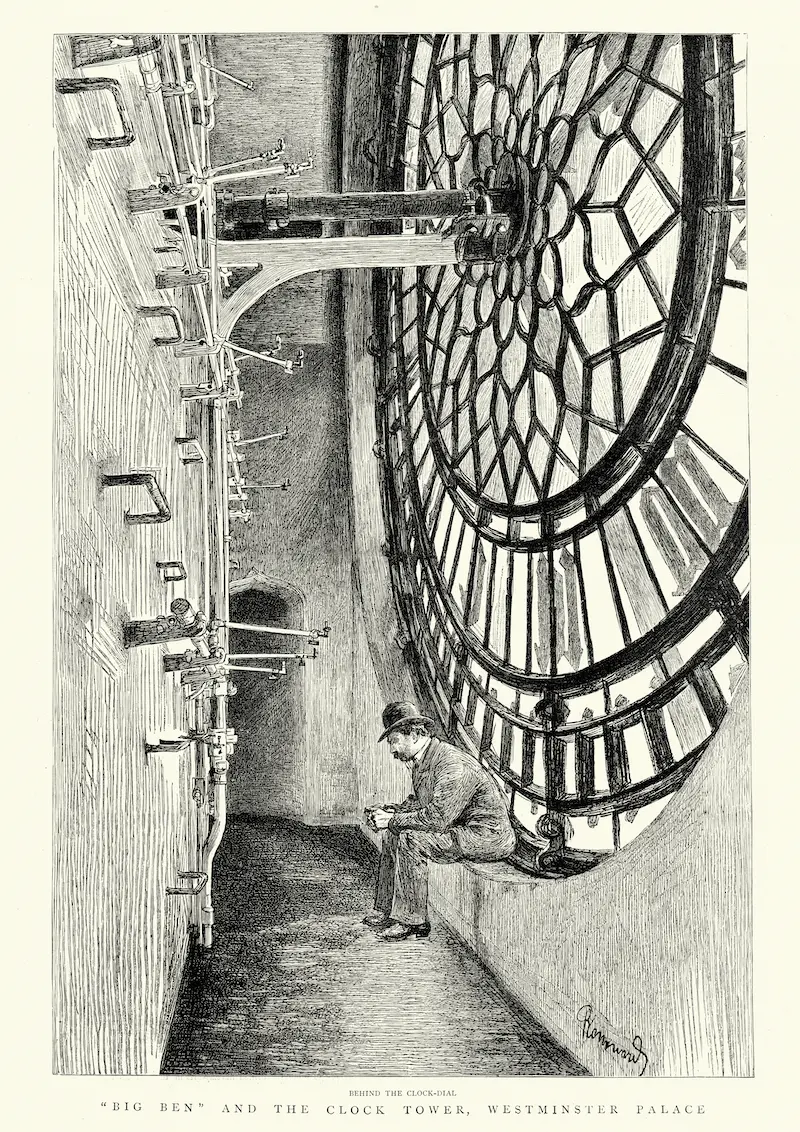
The lights behind the clock dials were part of the original design, and have been lit at night almost continually since the Tower was built. They were switched off for the duration of the Second World War. Originally lit with gas, electric lighting was installed in 1906.
Energy efficient lighting
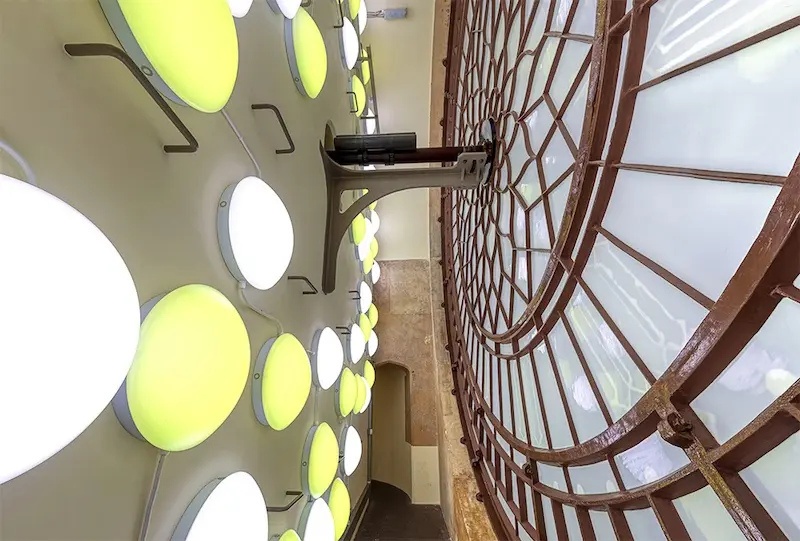
The dial is now lit by energy efficient LEDs, installed during the refurbishment project completed in 2022. A mixture of green and white lights up the dials with a familiar yellow glow.
Mechanism Room 1
Chiming Train
The Chiming Train creates the famous Westminster Chimes which play every 15 minutes. It is powered by a 1180kg weight underneath the mechanism. When released, this weight creates enough energy to turn the barrel, moving the wire ropes which go up to the belfry and operate the hammers on the quarter bells.
Going Train
The Going Train controls the huge hands on Elizabeth Tower’s four clock faces. A pendulum controls a 254kg weight, which drops every two seconds, turning the winding barrel. This turns one central shaft which moves four arbours out to the clock hands on the four faces.
Strike Train
The Strike Train creates the iconic bongs of Big Ben, the huge hour bell. A 1180kg weight drops below the mechanism in the weight shaft, turning the winding barrel. A single wire rope to the belfry is raised and this releases the hammer on Big Ben.
The mechanism at work
Mechanism Room 2
Pendulum
This pendulum is the timekeeper of the clock. The top third is visible here. The rest is hidden in the weight shaft below, where it is protected from the weather. The clock is kept accurate by a revoluntionary escapement device, invented by Denison. The ‘bob’ at the bottom of the pendulum weighs 230kg.
Moving the clock hands
The arbours move the clock hands on all four faces. They are connected via a shaft to the clock mechanism and travel out to the clock face, which you can see through the windows. The Going Train drives them every 2 seconds, slowly moving the hands around the clock.
Mechanism Room 3
Clock Winding
This is Dent’s Power Assisted Winder, which is used three times a week to wind the clock mechanism. Although historically wound by hand, in 1913 an electric motor was installed for the Strike Train, Chiming Train and Going Train, to help the clock mechanics maintain the clock.
Fly Fans
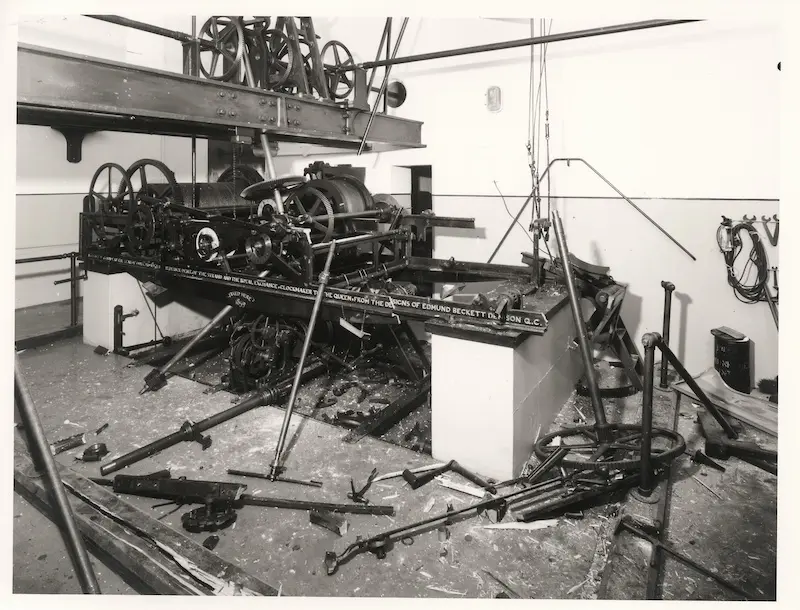
The Fly Fans regulate the speed of the Strike Train and Chiming Train by slowing the descent of the weights down the weight shaft. In 1976, a fly fan failure led to major damage to the clock mechanism as it span out of control, and the bells were silent for nearly 9 months.
Clock mechanics' log book
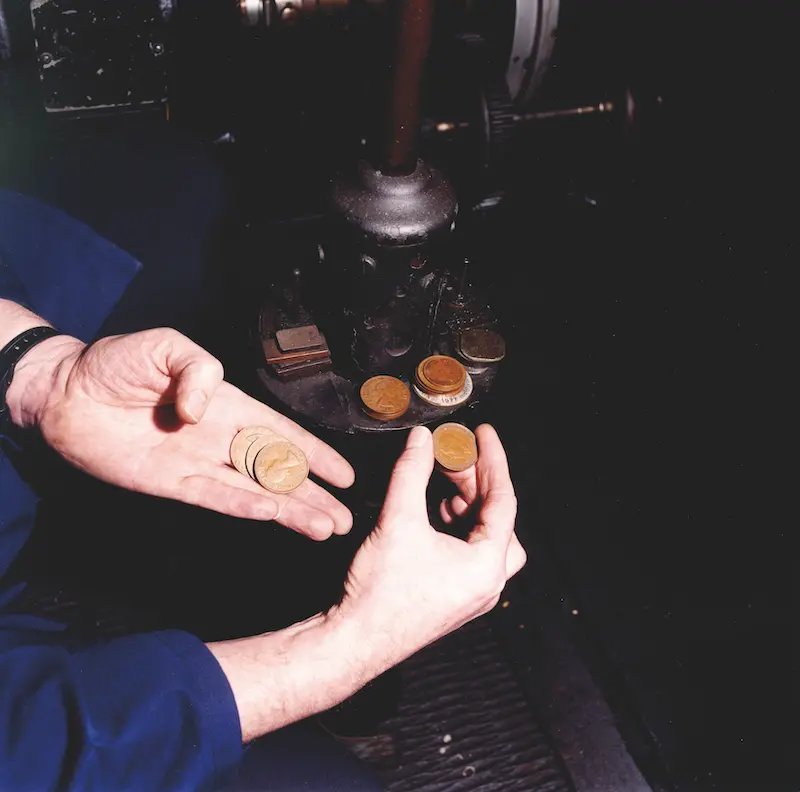
This logbook is used by Parliament’s clock mechanics to note the accuracy of the clock. Adjustments are made to the timekeeping by adding pre-decimal pennies to the top of the pendulum, each of which speeds up the clock by two fifths of a second per 24 hours.
